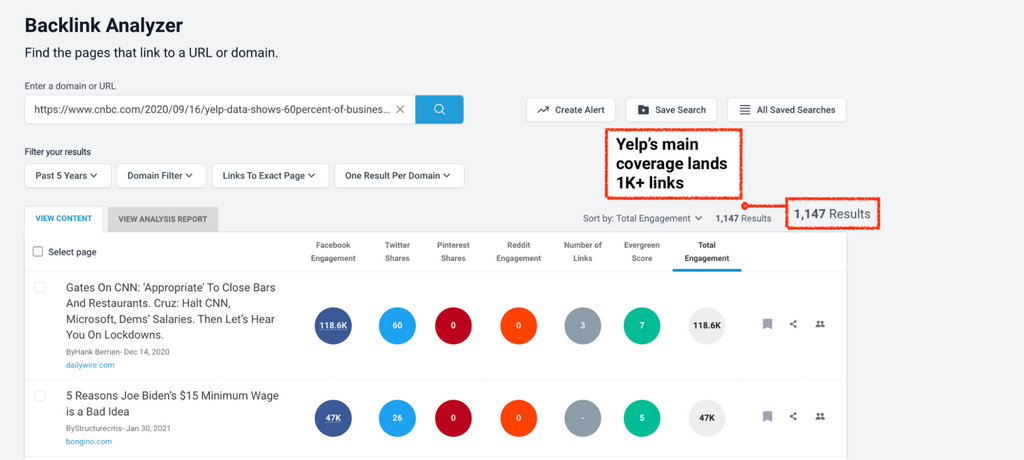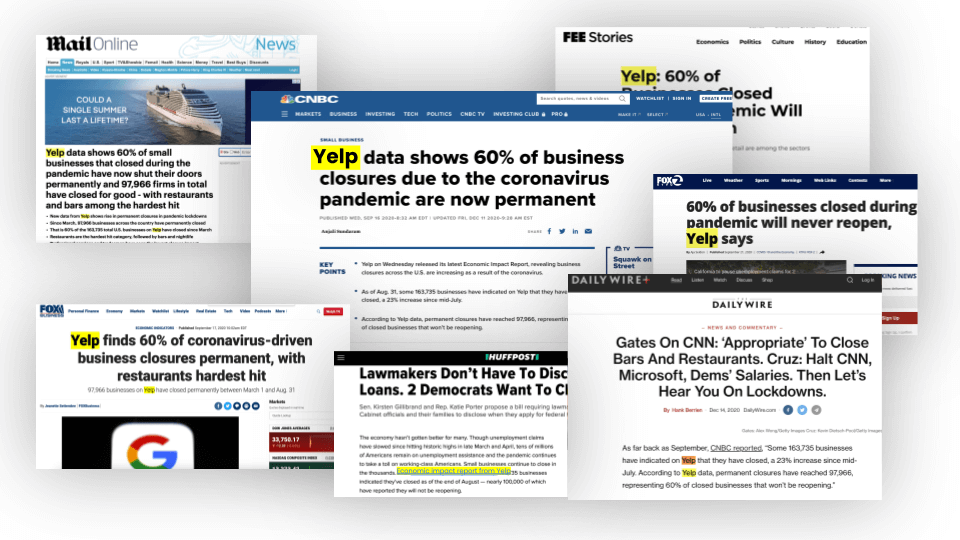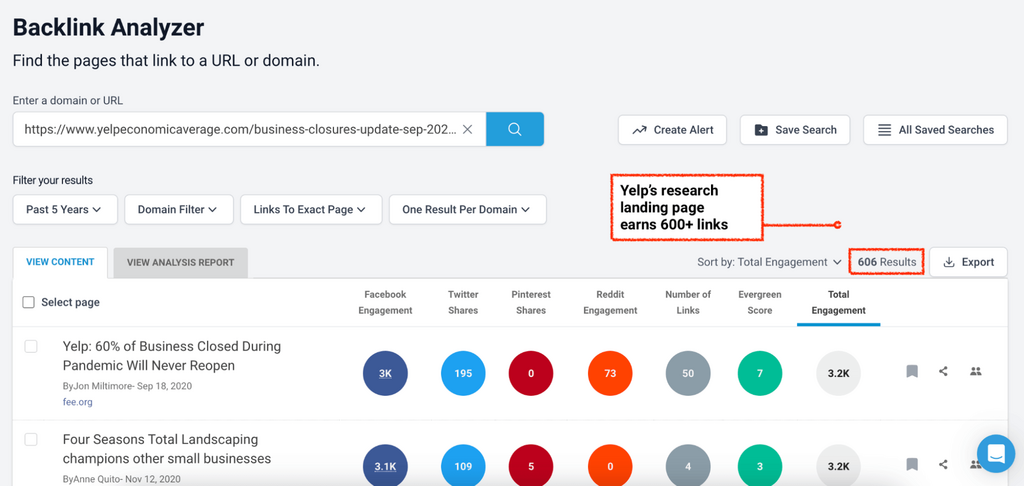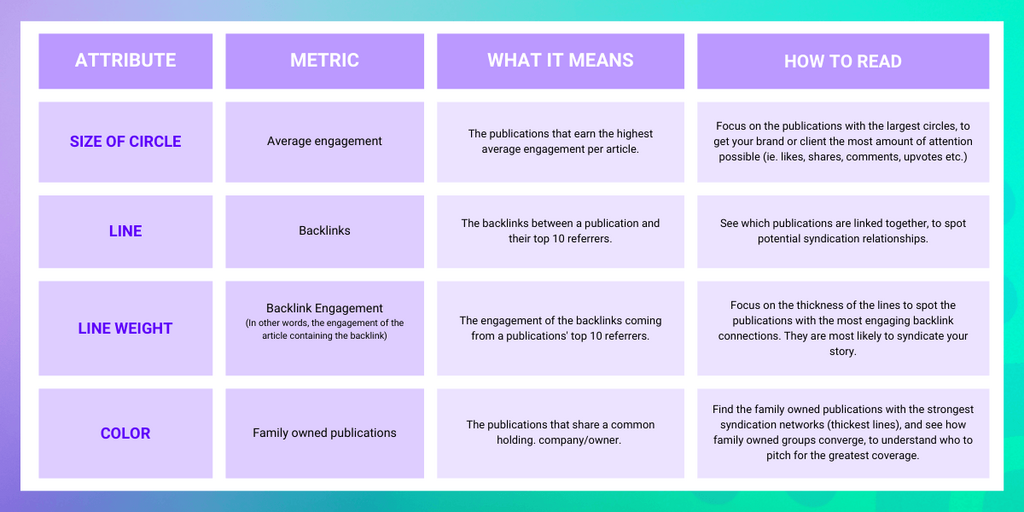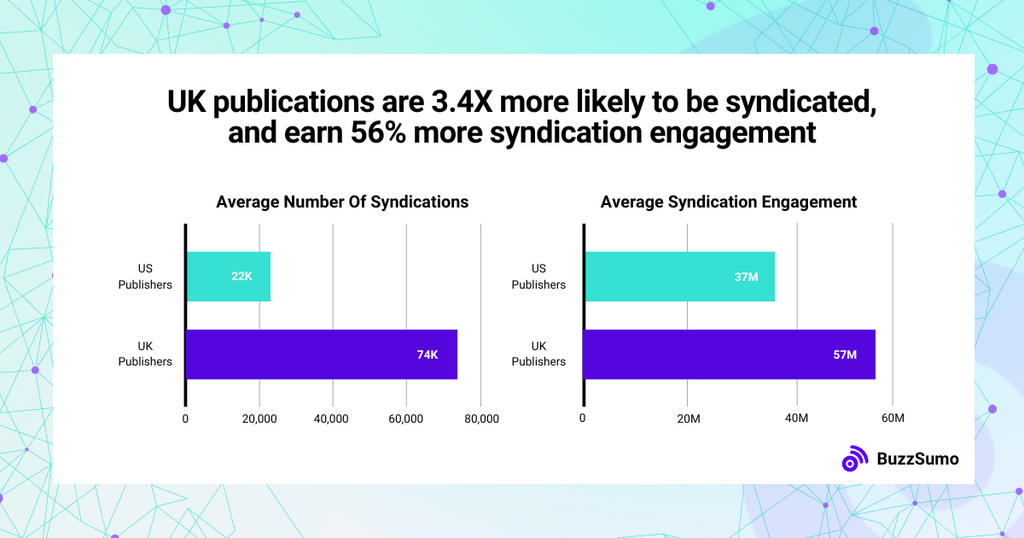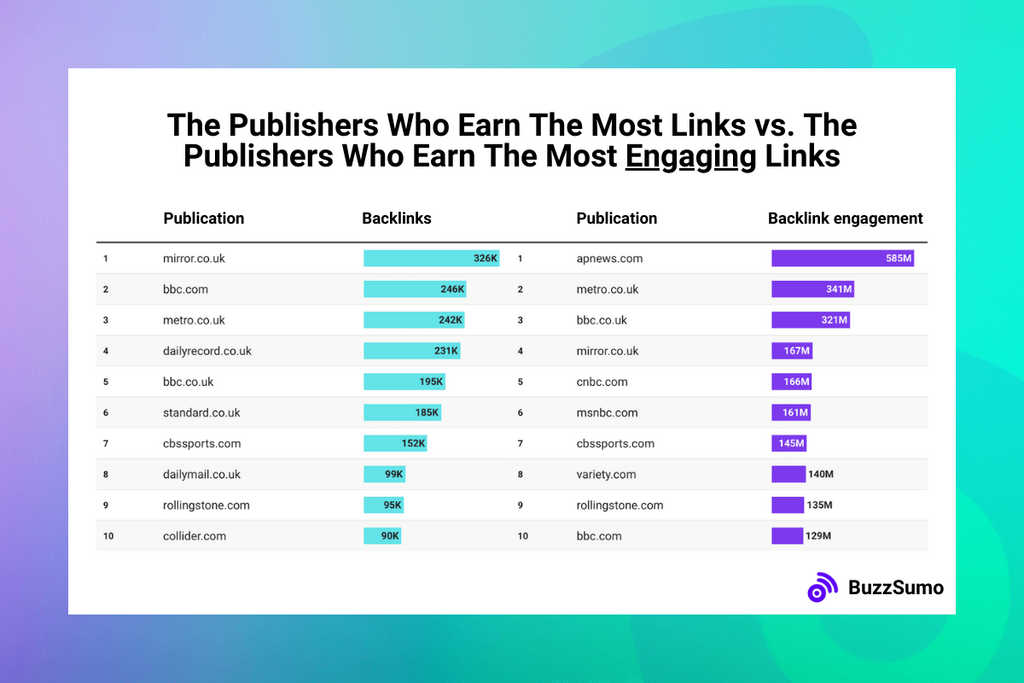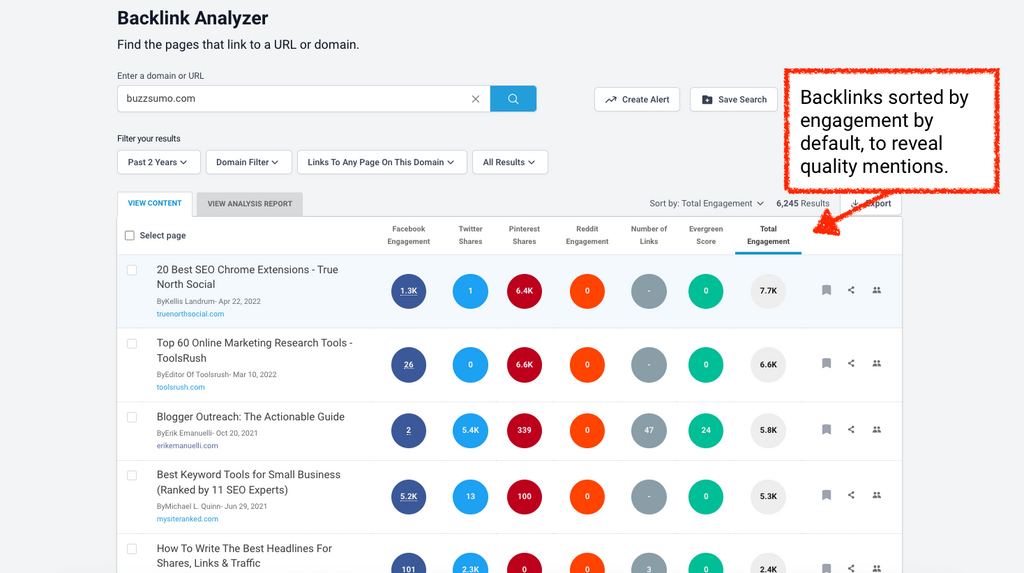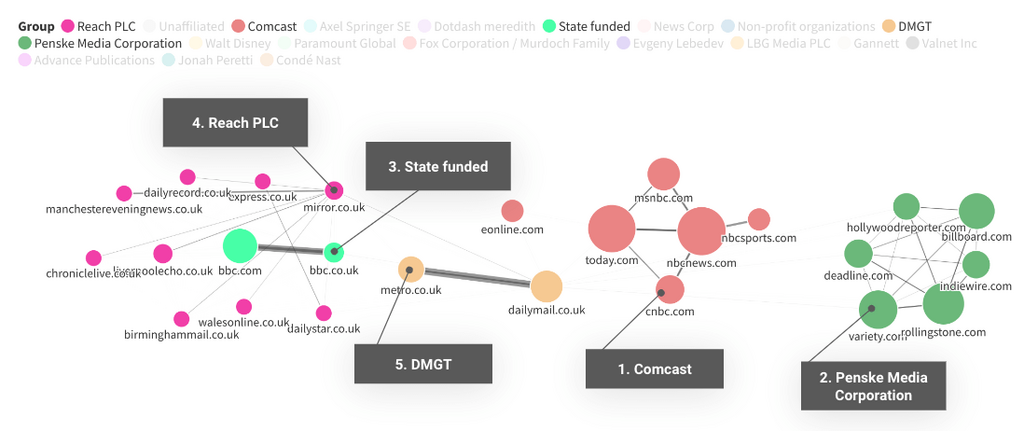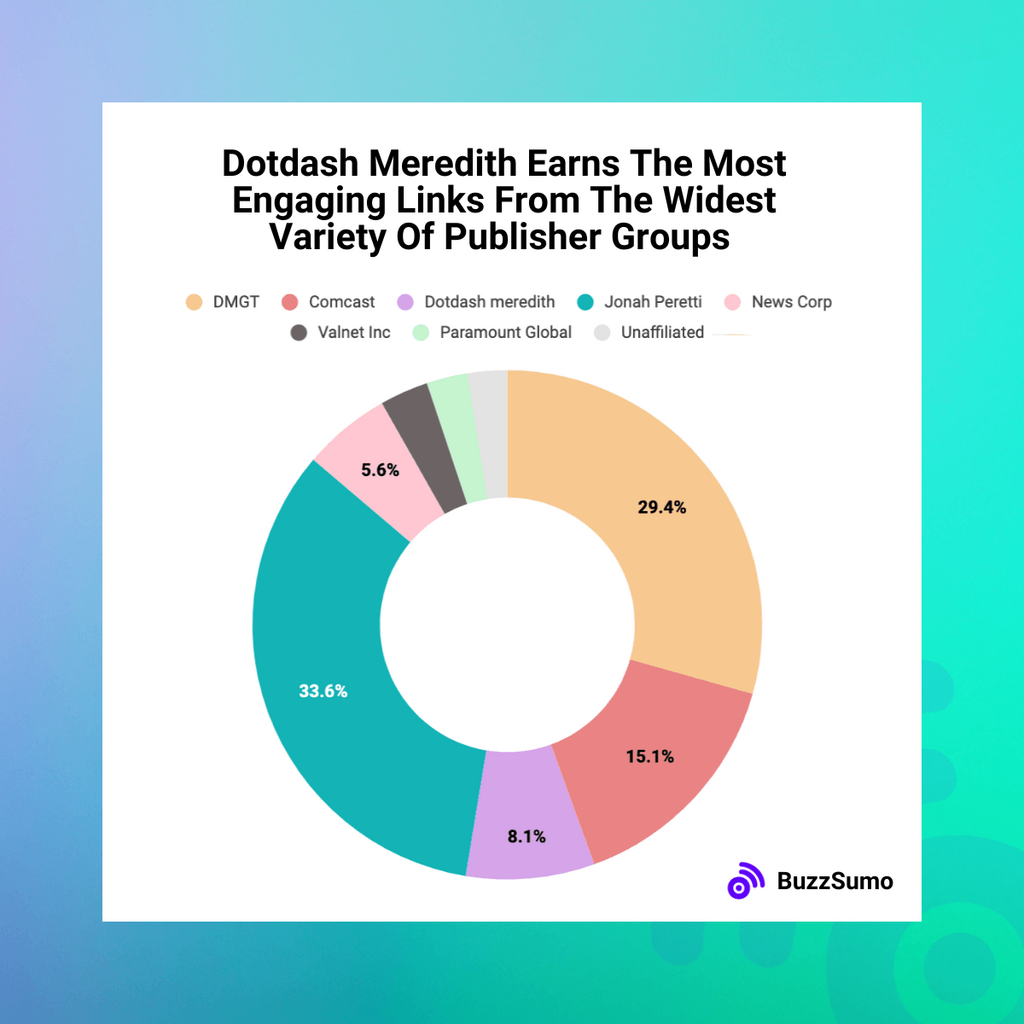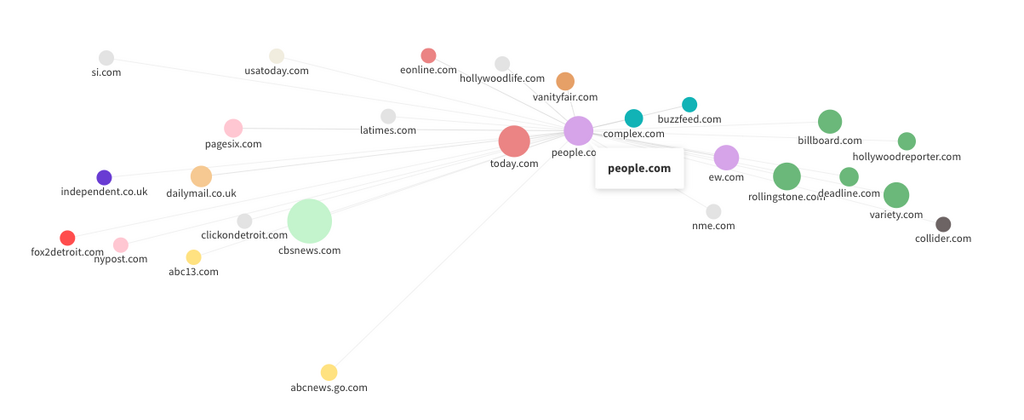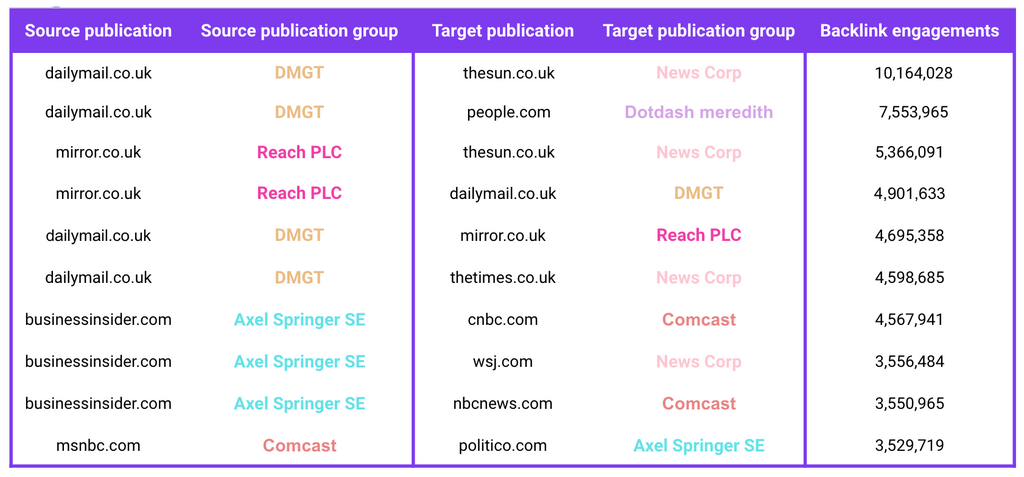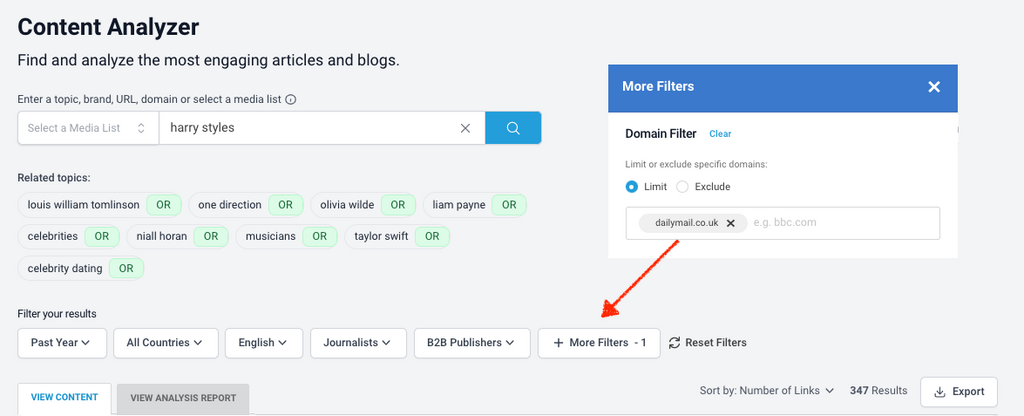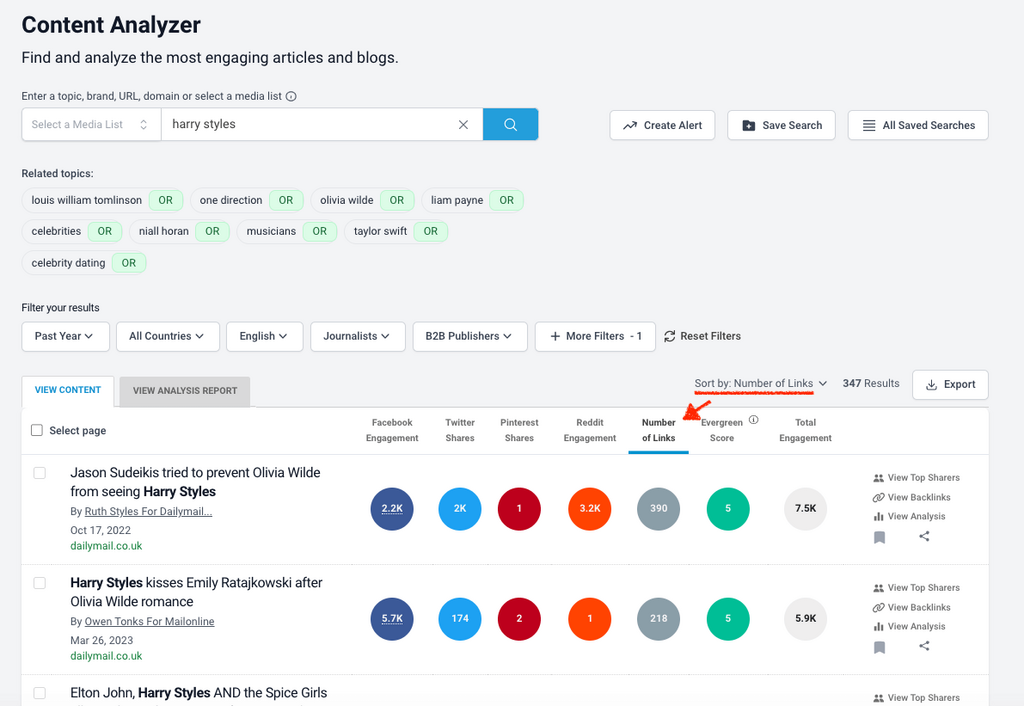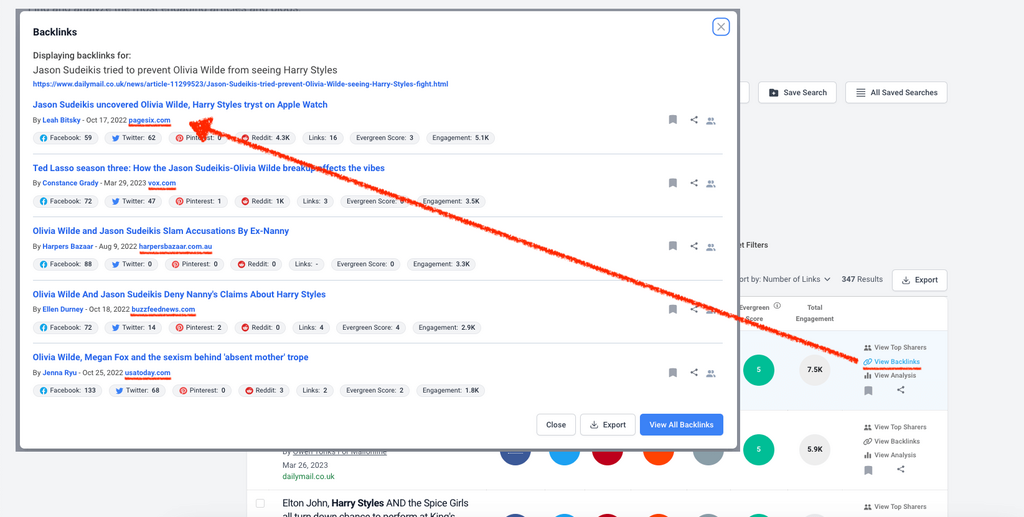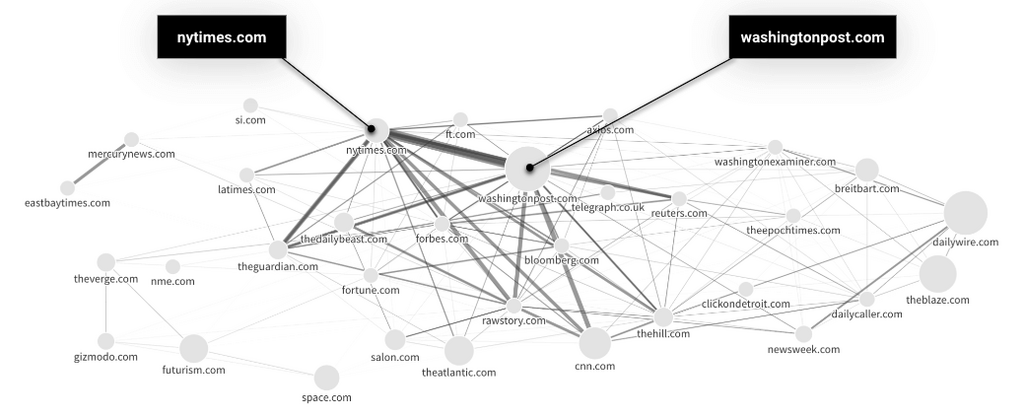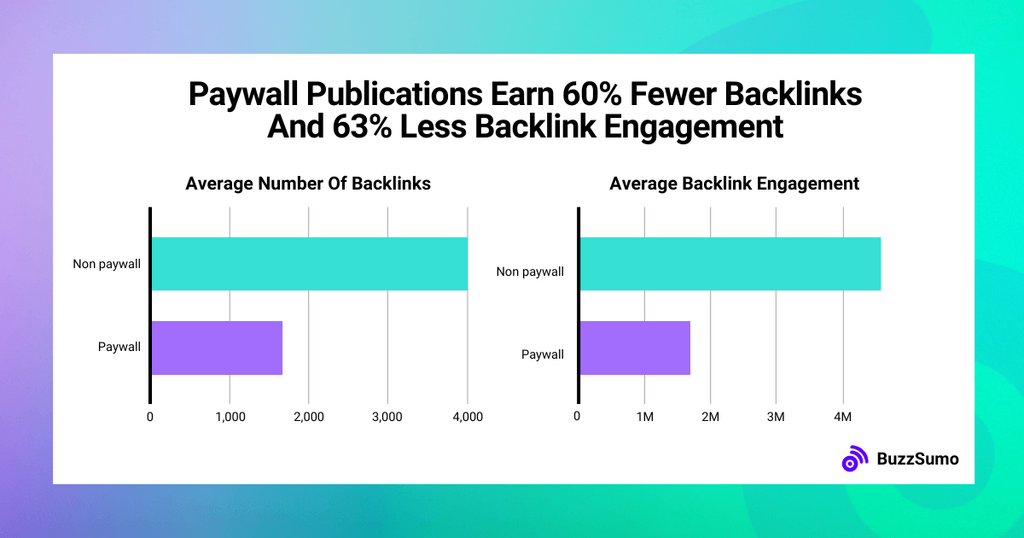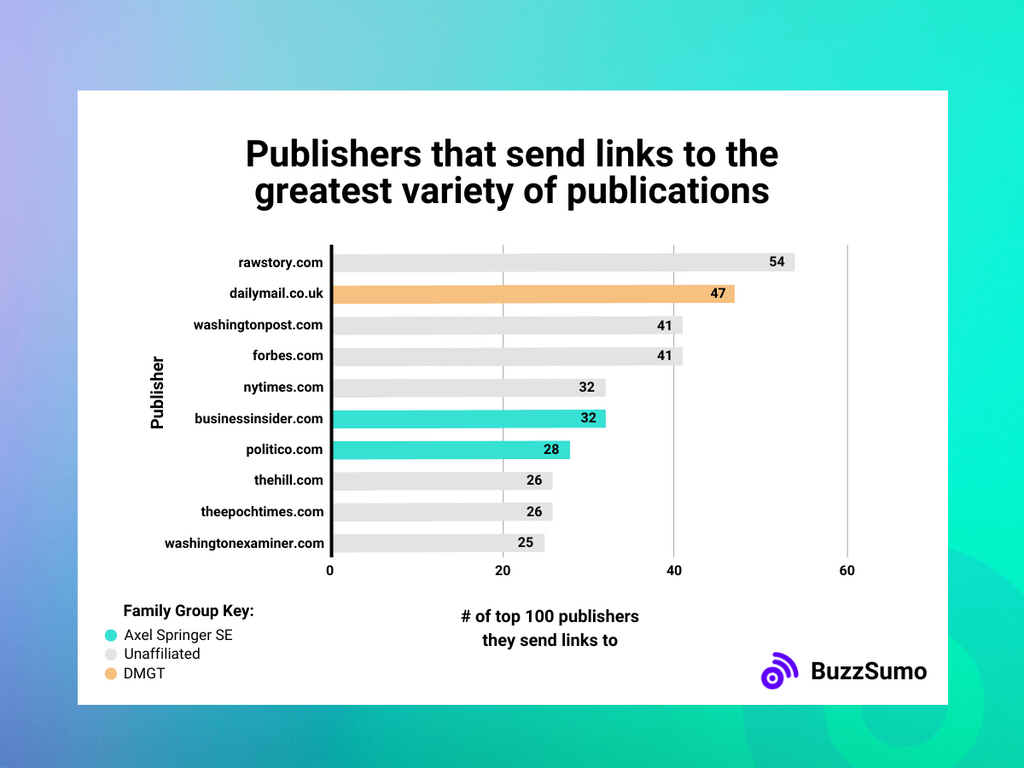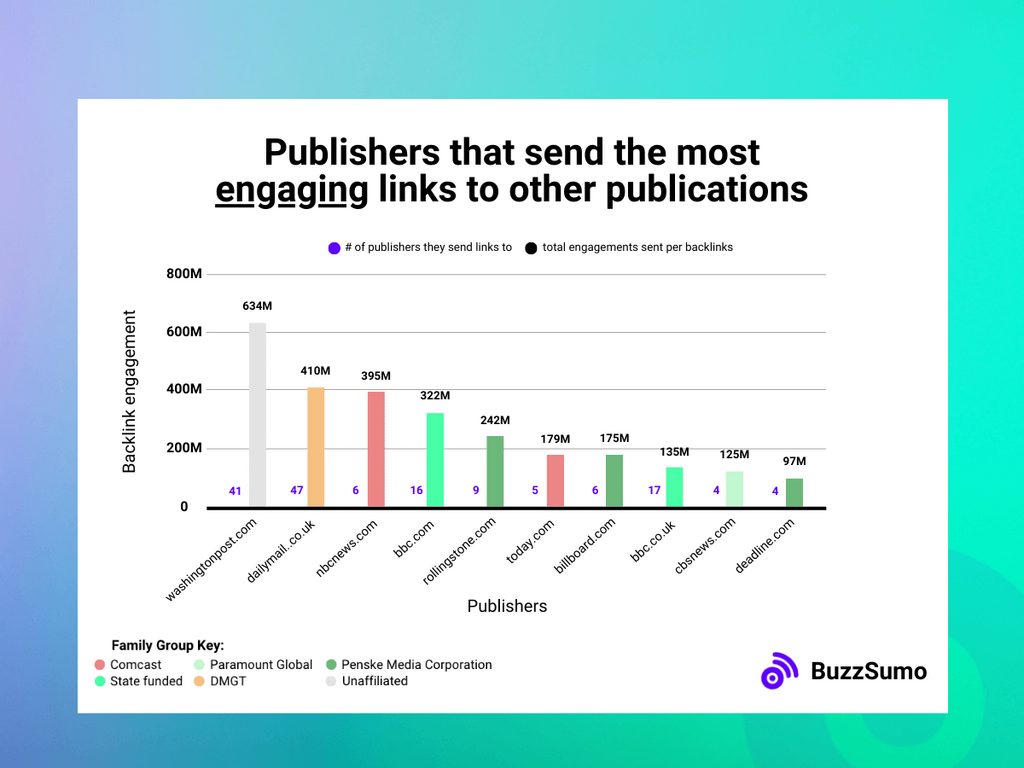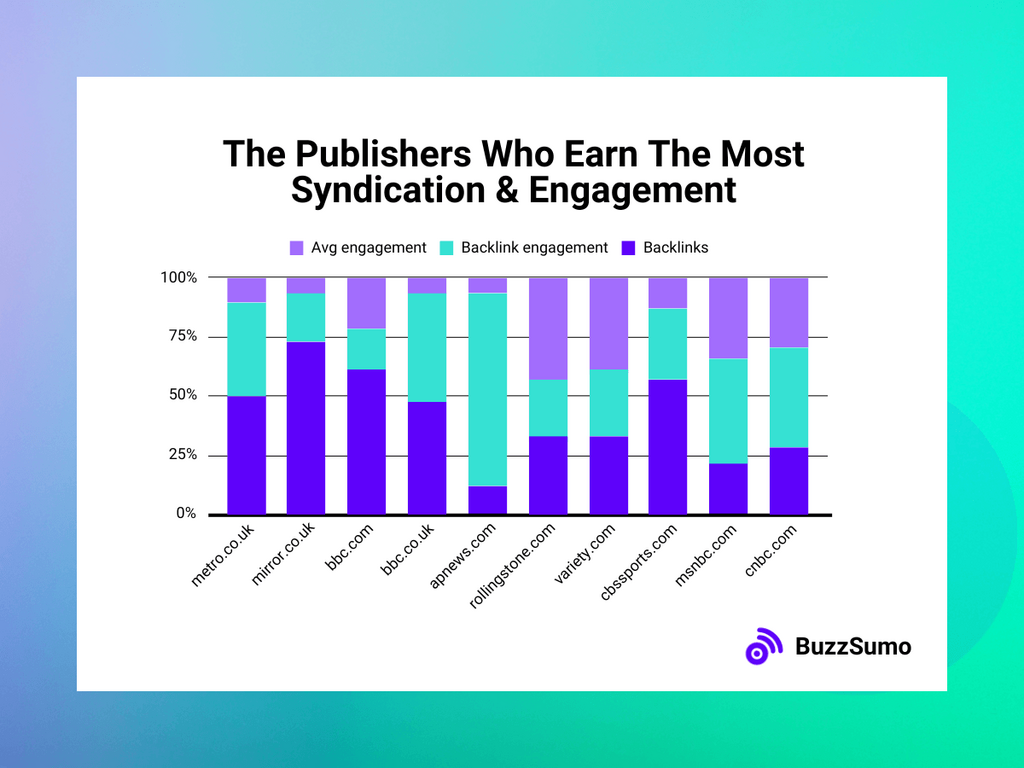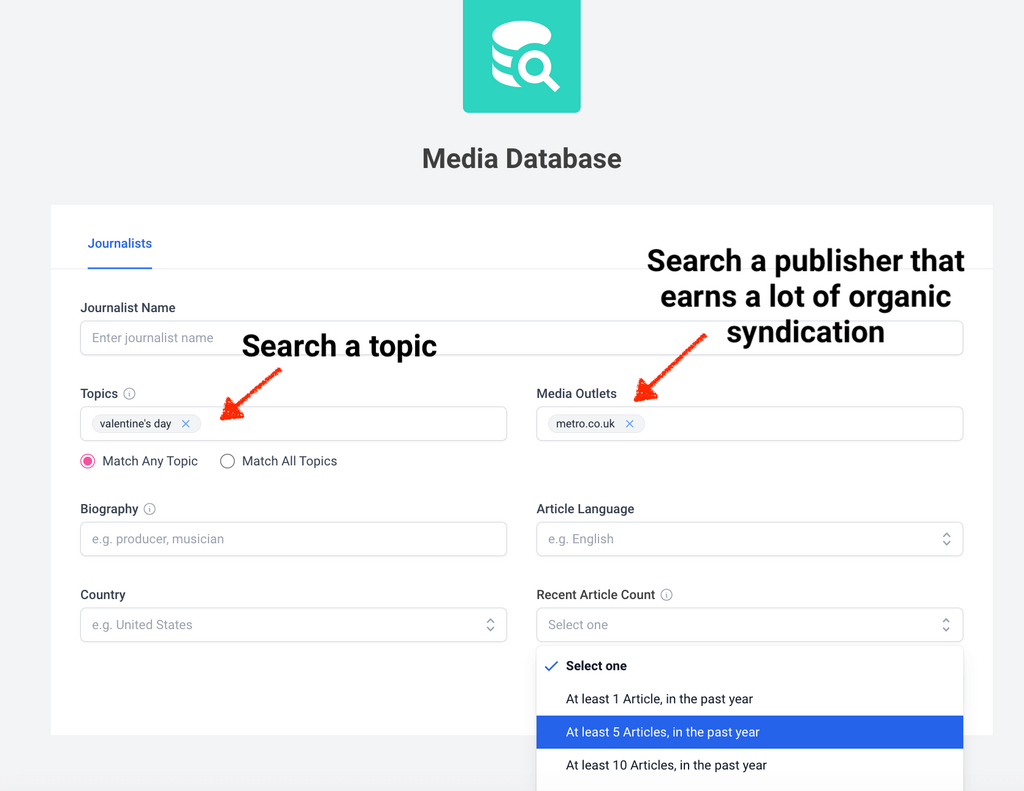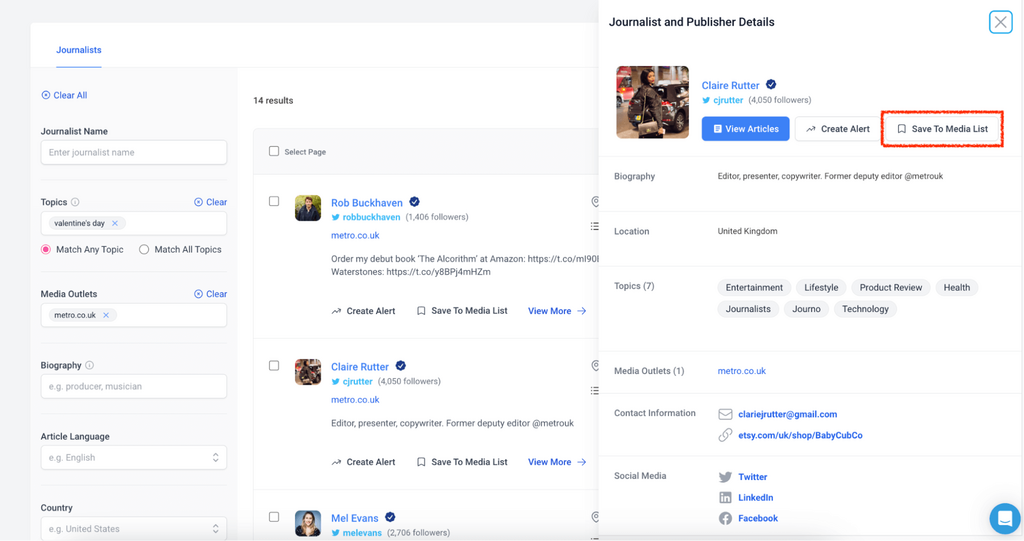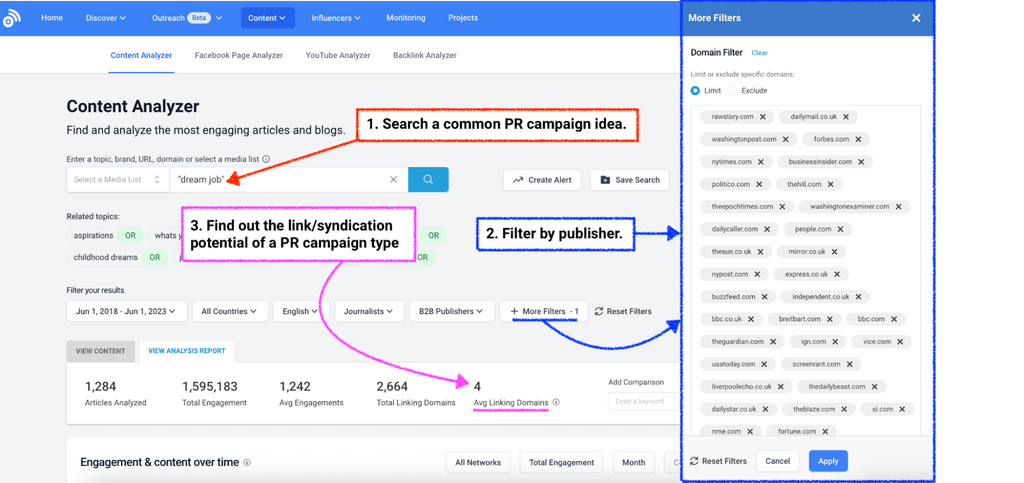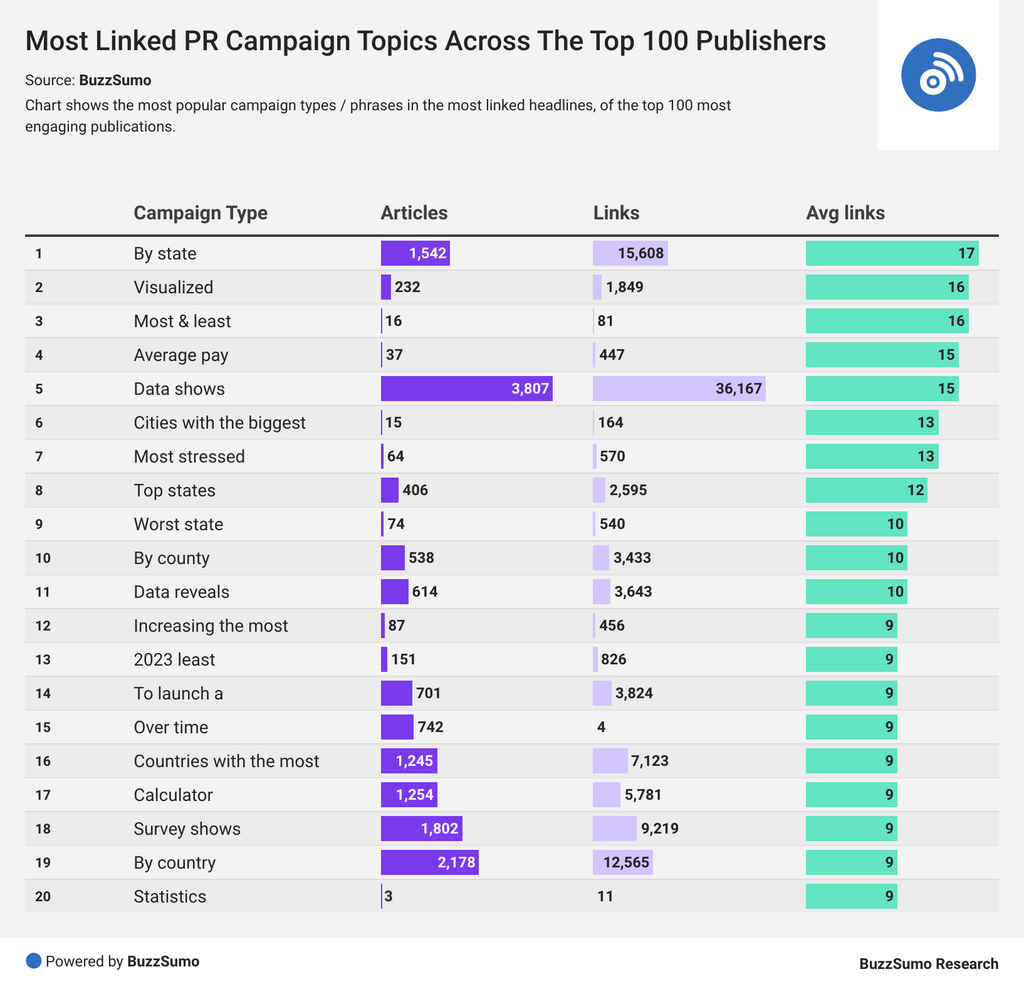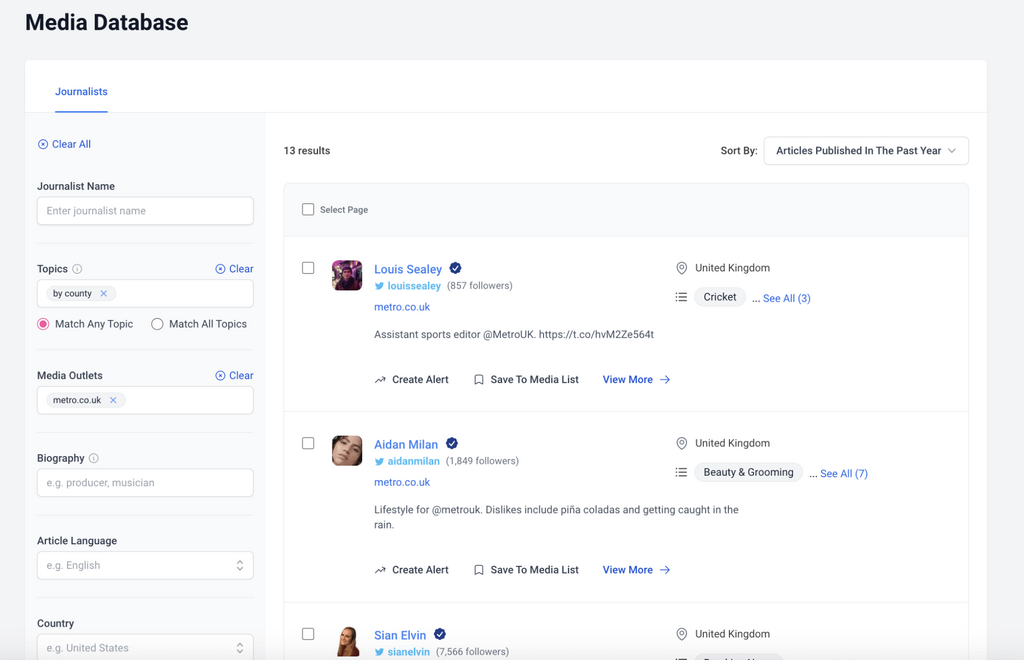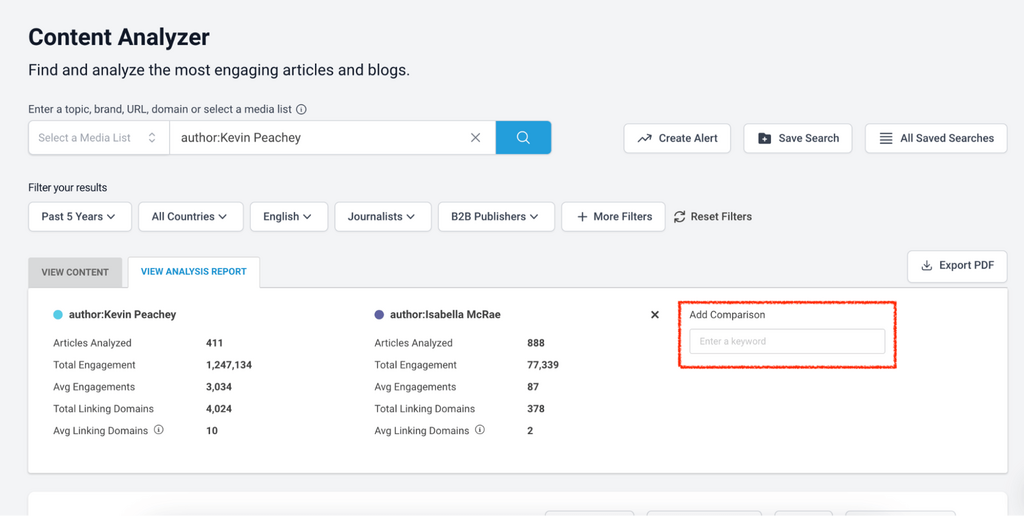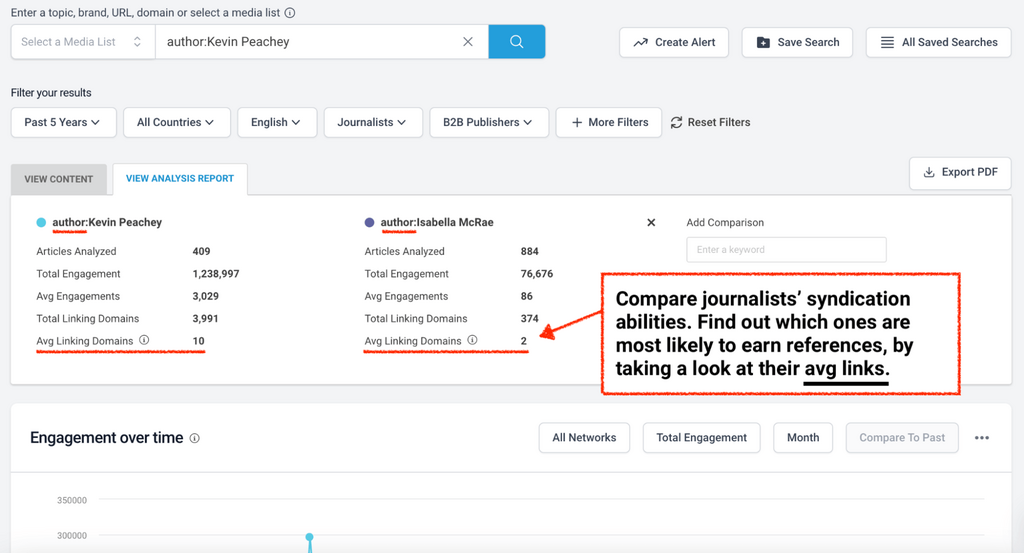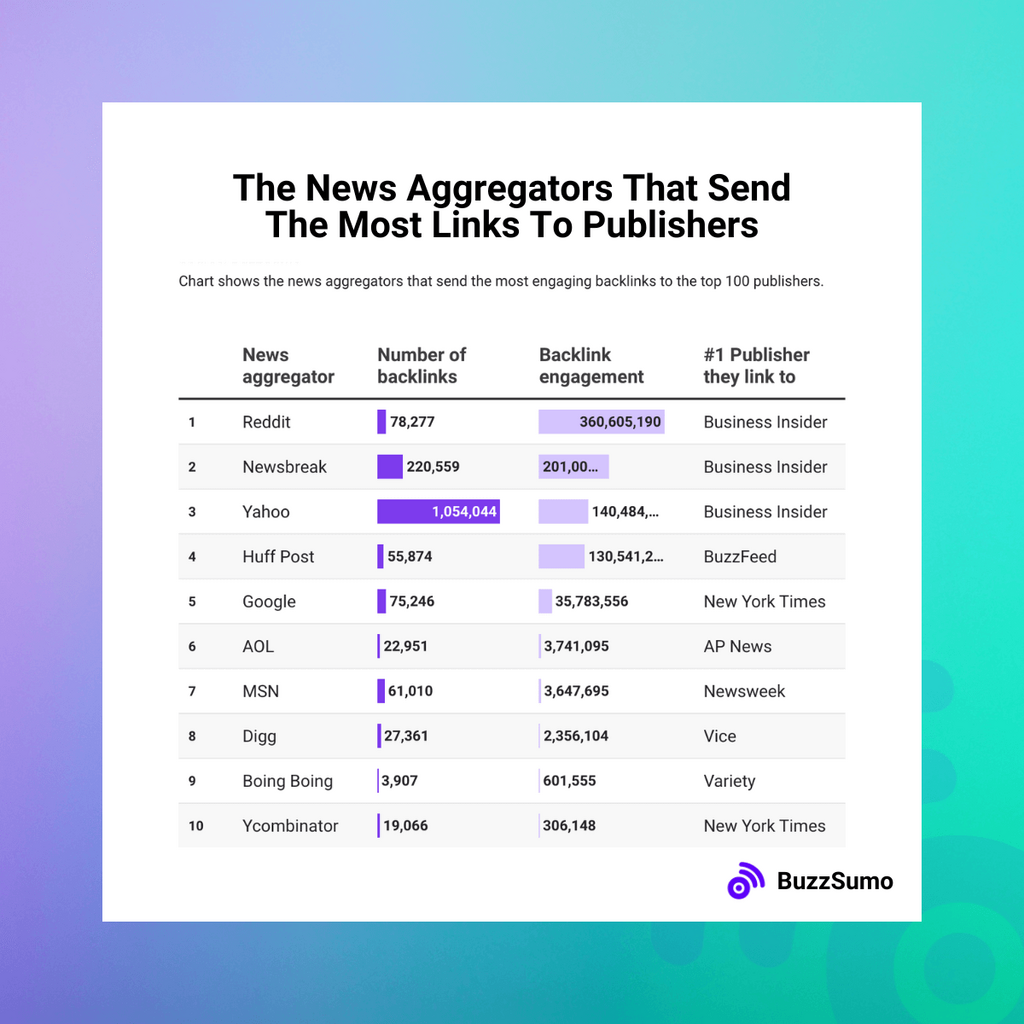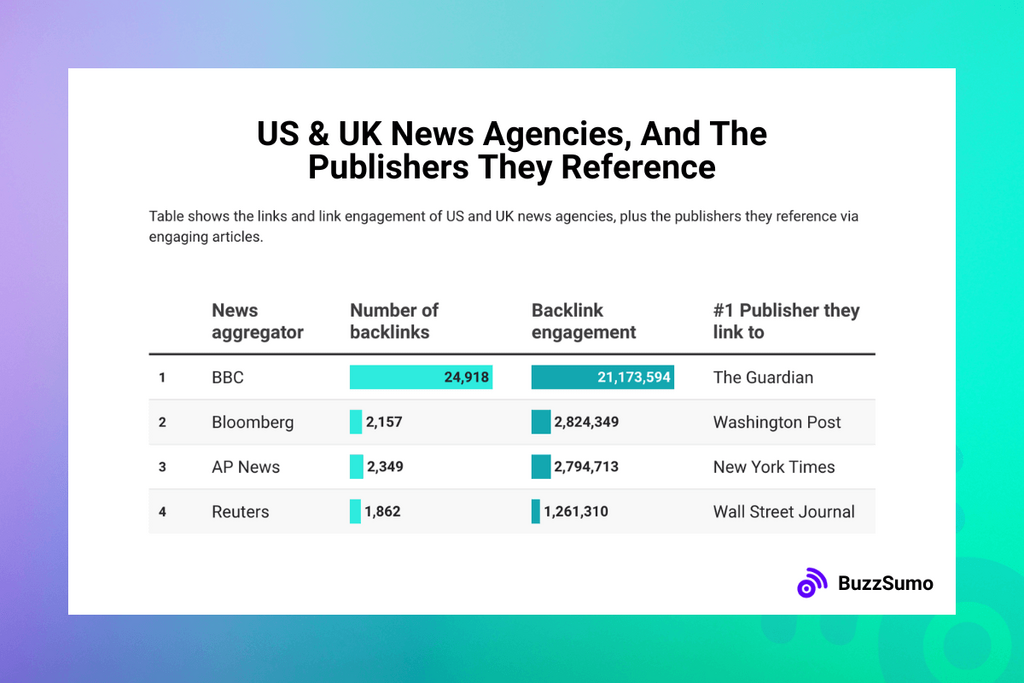Can you put a price on press coverage?
Well, while the right coverage is priceless, many press mentions come at a cost.
In fact, newswires exist for this very reason.
Despite the outlay, we often use these services because they near enough guarantee coverage and attention.
Why? Because newswires syndicate your content and PR.
That means they push out your story to a range of publications who republish or re-write that content, and (hopefully) drop you a reference.
But what if there were another way?
What if you didn’t have to pay for the privilege of coverage?
What if you could zero in on existing content / PR syndication networks, and pitch directly to publishers that other publications love referencing?
What if you could get more mileage out of your coverage, as your story spreads organically?
Wouldn’t that be the dream?!
Well luckily, you might be able to do just that, with our findings below...
Contents
- Top takeaways
- An example of press syndication
- We analyzed the networks of the top 100 publishers [interactive network map]
- What are the strongest publisher connections?
- Which publications earn the most links from other publications?
- Which family-owned publisher networks should you be pitching to earn syndication?
- Which separate family-owned networks syndicate each other?
- Which unrelated publications are most likely to syndicate each other?
- Build syndication into your creative brainstorms
- Which independent publishers should you be pitching?
- What implications do paywalls have on content syndication?
- Which publications are most likely to syndicate other publications?
- Which publications should you pitch to earn free content syndication, once and for all?
- Which publications are least likely to syndicate your stories?
- Which stories should you pitch to earn syndication?
- How do you find journalists who are most likely to syndicate your content?
- Which publishers should you pitch to get syndicated by news aggregators?
- Which news agencies should you pitch?
- Wrapping up
- Methodology
Back in 2018, US-based agency Fractl did some astounding link research. They mapped out content networks between hundreds of high-traffic publications, with some super interesting takeaways.
Five years on, we’ve decided to do our own analysis of publication networks, to show you how to capitalize on existing relationships, refine your content syndication strategy, and save a pretty penny.
We analyzed millions of links sent between the world's top 100 most engaging publishers, over the last year.
For each individual publication, we discovered their top 10 publication connections.
The top 10 were picked from within the same pool of publications (ie. the top 100), so that we focused on links (and inferred syndication) between the highest authority publications.
This allowed us to analyze:
- Their connections to one another
- Their ability to draw in links and, more importantly, engaging links
- Their family networks and connections
- Their propensity to use syndication services (like news agencies)
- The impact of paywalls on links and syndication
And more. Here's what we found...
Top takeaways
- Publishers DO syndicate each others’ stories! 88% of the top 100 publications link out to other publications in the top 100.
- Publishers link outside of their owned networks: 38% of those publications send their biggest number of links to publications outside of their family group.
- UK publications are 3.4X more likely to be syndicated on average vs. US, and gain 56% more syndication engagement.
- Pitching paywall publishers does mean your story is LESS LIKELY to get syndicated – Paywall publications earn 60% fewer backlinks and 63% less engaging backlinks than those without a paywall.
- Publishers that don't earn a lot of organic syndication include East Bay Times, MassLive, and Futurism.
- Localized stories and visualizations are the most likely to be syndicated in top-tier media.
- Getting coverage in Business Insider is most likely to help you get your story syndicated in news aggregator networks.
- Getting coverage in The New York Times will help you tap into the syndication network of the biggest news agency in the world: the Associated Press.
- Target your coverage towards News Corp (The Sun, The Times), The Daily Mail Group (DMGT), and Reach PLC (Mirror, Daily Star etc.). These groups show the strongest cross-syndication networks, meaning if you land coverage in one, you have a strong chance of being mentioned in the others.
- Get a placement in The Metro to give your story the greatest chance of gaining coverage and syndication.
An example of press syndication
Before we get going, if you're still a tad confused about what PR syndication actually means, here's a quick example.
A few years ago, Yelp published their local economic impact report.
The data was picked up by CNBC and written up as a feature piece on business closures, which then went on to gain natural coverage in 1K+ media outlets…
… from the likes of major publications including The Daily Mail, Fox News, Huff Post, and more.
Plenty of these publishers created feature stories paraphrasing Yelp's original research, some just mentioned the research in passing, and others copied it verbatim.
This led to Yelp’s original research (on their own site) syndicating in over 600 publications…
If you want to find out how you could do the same, keep reading…
We analyzed the networks of the top 100 publishers
Play around with the live data below. Discover publisher connections, and for more detail analyze the direction of the links in this chart.
Read more about how to use the chart below or jump to the methodology to get the detail on how we analyzed this data, and why we chose specific metrics.
How to read this chart
Hovering over a publication in the chart will show the publications sending links to them, and the publications they link out to.
If you can’t view a connection due to visual overlap in data, click + drag the publication to a different position.
You can also hold down on the publication you’re viewing, and the related publications will orbit around it to give you a better view.
A few (maybe unsurprising) things become clear when you start digging into the chart:
- Family-related publications see the strongest, most engaging backlink connections.
- Publishers that link outside of their own family group are often politically aligned with the other publication they link to (eg. outside of its own group [DMGT] the Daily Mail sends its most engaging backlinks to The Sun [News Corp]).
- Topically related publications tend to link to and cluster around each other.
Amanda Milligan
"This fascinating data visualization speaks to the often overlooked 'unofficial' connections between top publishers.
If you prioritize pitching authoritative sites that often syndicate stories, you increase your chances of getting significantly more value for each piece of content (and each pitch!)."
What are the strongest publisher connections?
Let’s start by analyzing the most engaging, individual connections between publications.
Scroll through the slider to see them in order.
Here’s a couple of things to note about these connections…
Slide 1: The Washington Post → Associated Press News
The Associated Press is a different kind of publication in that it’s technically a “News agency”.
AP News hires journalists to write articles, which then get published on their “wire” (usually an RSS feed) to subscribing journalists or media outlets.
Judging by the engagement of the links sent from the Washington Post to AP News (580M), it can be assumed the WP syndicates a lot of AP News’ content.
If you manage to land coverage in AP News, you stand a good chance of being mentioned in the Washington Post, which offers the second-highest average engagement per article of all the publications we studied.
Slide 5: CBS News → CBS Sports
In total, the CBS News articles linking to CBS Sports carry a casual 340M engagements.
If you have a sports story to pitch CBS Sports, it’s very likely to get syndicated across CBS’ general news site.
And that site offers the highest average engagement per article of all the publications we studied (illustrated by the size of its circle).
Slide 6: Comcast
There is heavy interlinking between the Comcast family publications.
Out of all family affiliated groups, it sends the most engaging links to its own sibling publications.
In fact, it is one of the most closed-off family networks, sending 95.3% of its most engaging backlinks to its own publications.
Kelsey Libert
"I *love* the research BuzzSumo is cranking out these days!
Understanding which sites have the largest syndication networks is crucial for Digital PR success: By targeting the most influential sites on any given topic, you can scale your results with the natural syndication that comes from the built-in networks and influence of these publishers.
What I love about BuzzSumo's research is it clearly demonstrates how UK sites can still help US clients earn relevant, high-authority .com links and PR traffic through syndication."
Which publications earn the most links from other publications?
The publisher that lands the most references from other publishers overall is The Mirror, with 326K links.
But the publisher that earns the most engaging backlinks overall is Associated Press News; racking up 585M engagements from its connections.
What does this mean? Well, although The Mirror earns the most links, if you win a pitch there, your story won’t necessarily get syndicated in the most engaging articles.
And ultimately, that means less coverage.
Think of it like this: Landing 100 links sounds impressive, but if the content containing those links earns zero engagement, then that’s a whole lot of nothing.
It’s like performing at The Colosseum… to nobody.
Whereas if you earn 10 links from 10 articles that land 50K engagements – yes the number of links is lower – but the quality of the coverage is significantly better.
Like performing in an intimate, yet packed-out venue at the Edinburgh Festival Fringe, to an audience that hangs off your every word.
So, when it comes to the quality of a link, AP News wins out.
The Metro, The Mirror, BBC, CBS Sports, and Rolling Stone win in both areas – these publications likely benefit from strong story syndication.
At BuzzSumo, we contextualize all our backlinks with engagement data, to help you prioritize your most engaging coverage.
Measuring the social engagement of syndicated content is more important now than ever
Earlier this year, Google made an official statement to say the canonical link element is no longer recommended for the “republished” form of content syndication (ie. content that has been copied verbatim) – as reported by Barry Schwartz in Search Engine Land.
Instead, it told PRs and publishers to no-index syndicated articles to avoid duplication, and prevent them from outranking the original story.
This means audiences won’t be finding syndicated stories as easily in the SERPs.
But syndicated content still gets shared widely on social media, making social engagement an even more important metric to consider in your earned content syndication strategy.
Katy Powell
"Content syndication can be a hotly-debated topic in the world of Digital PR. It’s important to understand how each network is connected (and you’ll probably be surprised at just how connected they are if you look at BuzzSumo’s research!).
It’s also really interesting to understand which publications have the most engaged with links, as of course, as much as we want a good quantity of links, links which actually get clicked on and engaged with are the dream.
In terms of syndication as a whole, approach this case-by-case with clients, discussing the pros such as brand awareness and traffic as well as keeping in mind your search goals."
Which family-owned publisher networks should you be pitching to earn syndication?
TL;DR:
- Comcast
- Penske Media
- DMGT
- BBC
- Reach PLC
First off, have a go at sorting the data to find out which family groups dominate in each category:
When you look purely at the number of links a family-owned publication earns, Reach PLC (Mirror, Daily Star etc.) takes top spot, racking up 670K backlinks in total across its own network.
But when it comes to the engagement of those backlinks, Reach PLC sits sorry in 7th place.
And when it comes to the average engagement it earns per article, Reach PLC drops to the bottom place (20th) of all the family networks.
Comcast publications, on the other hand, share the most engaging (internal) links of any family-owned publisher network overall.
In total, Comcasts' links (ie. within its own network) earn 680M engagements.
Hot on its heels with 670M backlink engagements is Penske Media Corporation, which consists of entertainment and lifestyle publications Variety and Billboard.
Pitch to the publications within these family groups for the best chance of syndicating your brand or client coverage across their network of highly engaging content.
Avoid pitching to Condé Nast publications if you want to tap into family PR link networks.
It is the least likely publication group to pass links internally.
In fact, the two Condé Nast titles that appear in our top 100 most engaging publications (Vanity Fair and Ars Technica) pass zero article links between one another.
Which separate family-owned networks syndicate each other?
TL;DR:
To syndicate across as many family-owned groups as possible, pitch News Corp or Dotdash Meredith groups.
So far, we’ve found out a lot about content syndication opportunities within family-owned publisher networks.
But, it isn’t that surprising to discover that publications owned by the same organizations will cross-promote and upcycle each others’ stories.
So, what about the connections between unrelated publishers? Or even unrelated networks?
Landing coverage in a family network that naturally syndicates content is pro-tier PR.
But landing coverage in two (or more) of these networks will help you ascend to another level entirely.
We analyzed which family-owned content networks share some of the strongest, overlapping connections.
Here they are in order:
Top takeaways:
- The News Corp network is the gateway to other engaging, family-owned networks.
- Try pitching News Corp publications to land coverage in DMGT and Reach PLC.
- Pitch to Comcast, the most engaging family-owned network, to also be referenced by the likes of Business Insider and Politico.
- Pitch BuzzFeed and Complex if you also want a chance of coverage in People and Entertainment Weekly.
As we know, family publications are extremely likely to syndicate content across their own group…
So pitching publications that earn links from the greatest number of family networks is a shrewd move.
Dotdash Meredith is friends with all the family-owned groups
Note that many family groups actually send more engaging links to Dotdash Meredith than they send to themselves – ie. Jonah Peretti [BuzzFeed]).
Landing coverage in People (a DM publication), for example, gives your story the potential to be syndicated across 8 other ready-established syndication networks, if picked up by these family-owned publications.
What’s even better is that individual articles published on People see high average engagement, as evidenced by the size of the circle in our network graph (see below).
Meaning that both owned and earned engagement from this publication is likely to be very healthy.
If you’re looking to infiltrate the widest variety of publisher networks, and earn syndication from far and wide, pitch People and Entertainment Weekly (Dotdash Meredith).
Tom Chivers
"This syndication report by BuzzSumo is the most impressive one I've ever seen – 6 million links analyzed is nothing to sniff at.
This insight will be incredibly valuable in helping PRs decide what publications to target their efforts towards.
People often think of the value of backlinks in simple terms, but what BuzzSumo has proven in this comprehensive report is that one link can go a long way."
Which unrelated publications are most likely to syndicate each other?
TL;DR:
- The Daily Mail → The Sun
- The Daily Mail → People
- The Mirror → The Sun
We’ve already seen that the single most engaging connection occurred between Washington Post and AP News – and thereafter all the most prominent links were between family-related publishers. Don't remember? Scroll back up to see what we mean.
So, what if we’d carried on down that list until we found publishers that weren’t related?
Well luckily… we did! This list will help you find out which publishers advocate for each other organically, to inform your pitching.
In the table below, the “Source publication” represents the one sending links, and the “Target publication” is the one receiving them.
As you can see, the strongest syndication between unrelated publications comes from The Daily Mail, towards The Sun – meaning that if a Sun journalist picks up your pitch and publishes it, there is a significant possibility that your story will also be written up by a journalist at The Daily Mail.
Pitching to any of these target publications will exponentially increase your chances of syndicating your PR, because you'll benefit from the networks of at least two publication groups.
Build syndication into your creative brainstorms
US agency Fractl use BuzzSumo in their campaign research process to assess a publisher or journalist, based on their ability to earn syndication naturally.
You can read more about that here.
"This research was built upon years of manually tracking the syndication of our content marketing campaigns to increase our understanding of industry-level link networks that would help us naturally scale our results."
Kelsey Libert, Co-Founder Fractl
And here's how to build syndication research into your PR campaigns from the outset:
Step 1: Head to the Content Analyzer
Step 2: Search your topic idea
Step 3: Limit your search to the publisher you want to pitch
Step 4: Sort by “Number of backlinks” to find their most link-worthy headlines.
Step 5: Analyze the kinds of stories your target publisher creates to pick up links
Step 6: “View backlinks” of those stories to get an idea of the kinds of publications you can expect syndication from.
Think about whether you can recreate the top link-driving stories in your own pitch, to have a greater chance of earning that free content syndication.
In some cases, a topic may not get picked up by other publications full stop, in which case you might want to re-think your idea.
Which Independent Publications should you be pitching?
TL;DR:
The Washington Post and The New York Times.
Independent Publications are either independently owned, or do not share a common owner with another publication.
The connections between Independent Publications shouldn’t be overlooked.
In fact, out of the 20 groups of publications we analyzed, Independent Publications ranked #8 when it came to the overall link engagement earned across the group; beating 12 family-owned publication networks.
The New York Times and the Washington Post sit at the epicenter of Independent Publications, with multiple other publications sending highly engaging links back to them.
The Washington Post (WP) is also the top publication in the Independent Publication category for average article engagement (see size of its circle above), earning 5,100 engagements per article.
Therefore, landing coverage in WP will give you a strong chance of earning both attention and links.
Interestingly, both of these publications sit behind a paywall and still manage to pick up a significant amount of engaging links.
What implications do paywalls have on content syndication?
TL;DR:
Paywall publications earn 60% fewer backlinks and 63% less backlink engagement
If you’re weary of pitching to paywall publications, our data shows you’re right to be.
In our analysis, we identified 17 publications with paywalls, and 83 without.
Paywall publications are 60% less likely to be linked back to, and therefore syndicated.
Non-paywall publications are rewarded with over double the amount of backlinks, and nearly 3x more backlink engagement.
Which publications are most likely to syndicate other publications?
TL;DR:
88% of the top 100 publications send links out to other publications and the Washington Post is the most valuable syndicator.
If you were in any doubt that publications syndicate each others’ content, you no longer need be.
We found that 88% of the top 100 publications send links out to other top publications, which is a strong indication of story syndication.
And 38% of those publications send their biggest number of links to publications outside of their own network/group.
For example, Vanity Fair, a Condé Nast-owned publication, sends its greatest number of links to People Magazine, a Dotdash Meredith-owned publication.
This goes to show that links and syndication isn't just a practice carried out by related or family-owned publisher networks. Media outlets aren't as insular as we might think, and don't just self-refer.
So, out of the top 100, which publications are the top referees? Let’s take a look…
Raw Story passed links on to the greatest number of publishers via its content. Out of the 100 publications we analyzed, it sent links to 54 other publications.
However, Raw Story’s articles (ie. the ones containing those links) didn’t actually carry a whole lot of engagement, meaning that if Raw Story were to syndicate your coverage, it may not attract much attention.
A publisher that does send through big engagement to numerous publications, on the other hand, is the Washington Post.
The WP sends a cool 634M backlinks out to 41 of the top 100 publications.
If your campaign was most likely to get syndicated by any publisher, it’s this one.
Which publications should you pitch to earn free content syndication, once and for all?
If you’ve got to this point, you’ve heard a lot about who wins the syndication race in numerous categories.
But, ultimately, you just need to know who to pitch for the greatest chance of winning press and engagement.
We’ve got you covered.
The following publishers are most likely to do a good job of earning you syndication in engaging articles.
They demonstrate the highest numbers in all three areas (backlinks, backlink engagement, and average engagement.)
These publishers not only earn a high amount of links from other top publications, they earn engaging links, and when it comes to on-site factors, they drive big engagement too; when you divide their social engagement (i.g. likes, shares, comments, and interactions) by the number of articles they write, they earn hundreds if not thousands of engagements per article.
So if you’re looking to get the most mileage out of your coverage, pitch:
You can find journalists from these publications to pitch using BuzzSumo’s journalist database.
Just search the publication, topic, and any other criteria…
Then find the most relevant and engaging journalists, and add them to your media list.
Get to know what makes them tick, and make your pitch relevant to them.
For more journalist pitching tips, check out our research of 600K journalist profiles here.
Will Hobson
Similarly to the report we’ve noticed when we gain pick up on key publications such as CNBC in the US, and the Dailymail in the UK, it leads to wider coverage and in some case TV coverage.
What I’d recommend doing as a PR is notice these connections and then focus on building key relationships with journalists at these publications.
It’s important to also notice which publications get the most social shares and engagement too, as these are the PERFECT publication for your audience.
We noticed this connection with a beauty brand of ours and one article went on to drive over 350,000 visits to our client's site and help sell out a product.
Making these connections can mean more than just press coverage it can mean revenue and brand growth”.
Which publications are least likely to syndicate your stories?
Now we know that 88% of publishers send some of their most engaging links to one another, let’s find out which ones are a little less generous with their link rewards.
These 12 publications are unlikely to syndicate your content in an engaging way:
- abcnews.go.com
- bloomberg.com
- ft.com
- ftw.usatoday.com
- hollywoodreporter.com
- markets.businessinsider.com
- npr.org
- reuters.com
- space.com
- telegraph.co.uk
- theatlantic.com
- thetimes.co.uk
Which stories should you pitch to earn syndication?
We took 650 PR campaign headlines and did a text analysis of the most commonly occurring one, two, and three-word phrases.
This included the sort of campaigns you often see in the press, like “You Can Get Paid To X”, or “World’s Happiest Countries”, or “Dream Job: Hundreds Apply To X.”
These campaigns appeared in the archive of the PR inspiration newsletters The Weekly PR, The Grapevine, and Bottled Imagination.
We then took those individual words and phrases, put them into BuzzSumo’s Content Analysis Report, and applied a “Domain” filter to limit our analysis to the top 100 most engaging publications.
This gave us the ability to discover which campaign types and topics drive the most links, on average, in top-tier media.
Location-specific headlines are a big link earner. Articles featuring the phrases “By state”, “Cities with the biggest”, “Top states”, “By country”, and so on, earn between nine and 17 links apiece.
In her report on “What Publishers Want”, Amanda Milligan notes that location-based headlines syndicate best as audiences have a vested interest in what happens in their “backyard”.
The other thing to note here is the element of comparison and ranking. Comparing different locations opens up your PR to numerous audiences, and appeals to publications that want to capture the interest of the masses.
If you want to make sure your PR stories naturally syndicate, you also need to be creating visual campaigns.
Take this headline from The Guardian, for example. It has earned 71 links from unique publishers over the last year.
While the visual / data in this article looks to have been curated by The Guardian in-house, this is exactly the kind of content that you could create and pitch as part of your PR campaign.
Headlines containing the UK and US spellings of all variations of the word “Visualize” land between 12 and 22 links on average, which isn’t to be sniffed at, when you consider that all content published by the top 100 publications averages 7 links.
Creating visuals of your own, primary data also gives you the unique opportunity to gain links and syndication, since it makes it harder for publications to forgo a reference.
In her syndication webinar with BuzzSumo, Amanda Milligan, Head of Marketing at Stacker Studio, notes that her clients’ most successful syndications are data-led for this very reason.
Mary Hickey
"It's really interesting to look at the data behind the most linked PR campaign topic, across the top 100 publishers. We are seeing a similar pattern at NORTH. When it comes to a campaign, journalists and publishers want to see hard data backing up the campaign. A brand or person telling a story isn't strong enough to cut through anymore. It needs hard data behind it to make it stand up and give it weight. Consumers love interesting stories, but they need facts and data behind it to differentiate the stories from gossip and rumour which is more prevalent than ever in today's news agenda.
Readers also like to read news and features that impact them directly, including where they are from. So it's no surprise to see regional content such as 'By state' and 'By county' proving popular in linked campaigns. The more relevant and personal you can make a campaign to individuals, the better its likely to perform.
Perhaps the most interesting takeout from the data is 'Visualisations'. The data shows that campaigns with a visual asset didn't feature heavily in the analysis, however when it came to the average number of links these campaigns came out on top. Digital PRs know how impactful visual campaigns are, and this data proves it. However budgets are getting tighter and campaigns with a visual asset can be costly and risky. This data suggests that though visual campaigns perform well, they are less common than they were a few years ago, with agencies and in-house teams being more cautious with budgets."
Pro Tip
Find topics that earn the most syndication
If you want to find out which headlines naturally syndicate across major media publications, just search your topic in the Content Analyzer, and hit the “Journalist” filter.
This will help you filter out non-media content (ie. B2B content, or blogs), and home in on press articles. If you need to refine the results further, change the “Publisher size” filter.
Then hit the Content Analysis Report tab, and pay attention to the average number of links the topic drives.
How do you find journalists who are most likely to syndicate your content?
Start off by heading to BuzzSumo’s journalist database, and search by name, topic, publication, and so on.
Once you’ve found the top journalists, take them over to BuzzSumo’s Content Analysis Report.
This next step is crucial if you want to know whether a journalist has the power to spread your story beyond the realms of the publication they write for.
Do an “Author” search for your journalist, and in the “Add comparison” box, add another. You can analyze up to 10 journalists at a time.
This essentially shows you the average engagement and links they are able to drive with their content.
This will help you prioritize your pitching to focus on the journalists who have the potential to earn you top coverage through syndication.
Which publishers should you pitch to get syndicated by news aggregators?
News aggregators curate news content from hundreds of different third-party sources, and come in many different forms and varieties.
They can be link directories of news headlines, like All Top.
Publishers like Huffington Post and Drudge Report also count as news aggregators, since they supplement their own first-party content with third-party news via RSS Feeds.
Web-based feed readers, or feed reader applications like Feedly or Inoreader also count as aggregators.
Websites like MSN either paraphrase or republish third-party news on their own domain.
Even tech-owned brands, like Google, Bing, and Yahoo curate news content. They do so mainly through automation (ie. algorithms), with some manually added sources for good measure.
And then, of course, you have your social news aggregators like Reddit.
Why am I telling you all of this? Well, these news aggregators send A LOT of links, and syndicate A LOT of content.
Meaning if you get coverage in a publication that news aggregators tend to syndicate, you’ve struck PR gold.
So, who are the top news aggregators, and who do they syndicate most?
Reddit, NewsBreak, and Yahoo send the most engaging backlinks of all news aggregators.
They also have another thing in common; they all send their most engaging links to Business Insider.
Featuring in Business Insider, BuzzFeed, or The New York Times will give you the greatest chance of piggybacking on news aggregator audiences, thereby extending the lifecycle of your coverage.
A PRs ultimate goal from coverage is usually to drive links back to their brand or clients’ website.
Some aggregators are just link directories, while others actively rewrite and republish your coverage (ie. MSN, Yahoo etc.).
These are more valuable, since they’re more likely than link directories to not only seed your coverage, but to republish that all-important link to your brand or client's website, placed within that coverage.
Iona J Townsley
"Targeting publications known for syndication can turbocharge your PR activity by seeding your story in hundreds of websites without the heavy lifting.
However, if you’re engaging in digital PR with the intention of links, you should keep an eye out for coverage where journalists haven’t included a link.
You can reach out to them personally and ask them to link back to the campaign page to add value for their readers."
Which news agencies should you pitch?
News agencies like BBC and AP News hire their journalists to write articles, which then get published on their “wire” (usually an RSS feed) and are sent out to all their subscribing news publications.
If a journalist at one of these news agencies picks up your story – either via your pitch email, or via a published article – and then drops you that all-important link, that could equal hundreds, if not thousands of top-tier syndications.
You’re most likely to get syndicated across the BBC news agency network if you already have coverage in The Guardian.
If you want to get picked up by the biggest news agency in the world (ie. Associated Press News), aside from pitching them directly, you should try to gain presence in The New York Times.
AP News is most likely to reference and repurpose stories from this publisher.
Wrapping up
When it comes to press coverage, the right kind of exposure is priceless.
When pitching, think carefully about your content syndication strategy.
Zero in on the publishers and journalists that have the ability to earn you links and engagement beyond the realms of just their owned content.
Tapping into the right syndication networks can help you pick up a significant amount of passive coverage, and maximize the value of your PR efforts.
And don’t forget to consider the quality of coverage during your research. While landing many links is impressive, if the content lacks engagement, it's like performing to an empty audience.
By analyzing publisher syndication networks, we've discovered some key takeaways.
- Publishers do syndicate each other's stories, and pitching to paywall publications reduces the likelihood of syndication.
- Visualizations and localized stories have a higher chance of being syndicated in top-tier media.
- When it comes to family-owned publisher networks, Comcast and Penske Media Corporation send the most engaging links within their owned networks. Pitching to these groups can lead to syndication across highly engaging content.
- Avoid pitching to Condé Nast publications, as they are less likely to pass links internally.
- Pitching to Dotdash Meredith (People and Entertainment Weekly) allows your story to potentially be syndicated across multiple networks.
- Unrelated publications like The Daily Mail and The Sun have a strong connection, so pitching to one increases the chances of coverage in the other.
Consider building syndication research into your PR strategy from the beginning. Use tools like BuzzSumo to analyze link-worthy headlines and identify publications that are likely to syndicate your content.
In the end, understanding publication networks and leveraging existing relationships can save you money while increasing the reach and impact of your press coverage.
So go ahead and make the most of these insights to boost your PR game, and achieve broader syndication for your brand or clients.
Methodology
We identified the top 100 most engaging publications from our Content Analysis Report tab, with the following filters appended:
- Date filter: 1 year
- Country filter: All countries
- Journalist filter: Content written only by journalists
- Domain filter: Excluded https://youtube.com
The Data points
The top 100 most engaging publications
- 6 million + links analyzed
- 876 million articles analyzed
- 4 billion backlink engagements analyzed
Please note that BuzzSumo tracks online content – ie. articles, blogs, videos etc. Therefore the links analyzed will point only to publication articles – not webpages, footer links, etc.
NB: Not all links in this study will be representative of syndicated media. That said, the research proves that major, unrelated publications do pass significant authority to each other. Studying the connections between the content of the top 100 most engaging publishers goes a long way to inferring syndication, or at least strong connections.
What do the metrics analyzed in the chart mean?
Average engagement
We analyzed the engagement that a publication earns for each article they publish.
Why did we choose this metric?
If you pitch to a publication, you want your brand or client to get the most amount of attention possible. PRs have long focused on a publication's "Reach score" when reporting on coverage. This is essentially the traffic or impressions a publication generates overall. The problem with reach scores is that they are extremely broad, and in no way tied to individual coverage. Social engagement, on the other hand, is, and is a metric that journalists are increasingly targeted on. The total engagement of a publication is more focused than a reach score. But if a media outlet publishes reams of articles with relatively low engagement, then a high total engagement score is misleading. This is why we chose to focus on average engagement. It involves dividing the number of articles a publisher writes, by their overall engagement, and gives you a more realistic idea of individual article engagement – ie. the amount of attention a placement could drive in said publication.
________________________________________________________________________________________
Backlinks
We analyzed the top 100 most engaging publications. For each individual publication, we discovered their top 10 backlinkers. But these top 10 backlinkers were picked from the same pool of publications (ie. the top 100), so that we focused on links from only the highest authority publications.
Why did we choose this metric?
You want your coverage to be organically referenced by other publications, so that it naturally syndicates. Analyzing a publications' ability to pick up backlinks from other publications will help you do this. A backlink is a reference. Even if it's not verbatim content syndication (ie. where your story has been republished word for word), it infers syndication or a strong connection. Spotting the connections between publications can guide your pitching efforts, and help you focus on outreaching to media outlets the have the ability to spread your story further than their owned site. We focused our analysis on a closed group of the most engaging publications, as these are the ones that are most likely to drop high quality, relevant links. Another benefit of limiting the analysis to links shared between publishers is that they're also more likely to represent syndicated content. If we had opened up our analysis to any site (ie. ecommerce, B2C sites, etc.) the links analyzed would be less relevant, and therefore less likely to be syndicated.
________________________________________________________________________________________
Engagement of backlinks
We worked out the engagement of the backlinks coming from a publications' top 10 referrers.
Why did we choose this metric?
The number of backlinks pointing to a publication is interesting to know, and goes some way to revealing the authority of their network, but what if those backlinks all come from low authority sites with low traction articles? To prioritize value over volume, we chose to focus on the engagement of the articles containing those backlinks – ie. the ones that are most likely to drive true attention for your brand or client.
________________________________________________________________________________________
A huge thank you to Henley Wing-Chiu for, Co-Founder of BuzzSumo, for painstakingly collecting the data for this study 💙
Categories
Digital PRThe Monthly Buzz⚡
Subscribe to BuzzSumo's monthly newsletter to:
Stay up-to-date with the best of the best in content marketing 📝
Get data-informed content, tips and tidbits insights first 👩🏻💻
Read top shared content by top marketing geeks 🤓
Try
Enter any topic, term or url to search to see BuzzSumo in action. It’s free!
100% free. No credit card required.

